How to Set Up Dolby Atmos Spatial Sound on Windows 10
If you patched your Windows 10 with the Creators Update, you’d be pleased to know that it has added support for Dolby Atmos. Windows 10 is a little late to the party, as Xbox One and PlayStation 4 embraced this sound technology right from the get-go. While you need to invest serious dollars in Atmos-powered hardware to get the absolute best of this technology, you can also go the cheap route and try a piece of Dolby’s Atmos object-based spatial sound for free. The best part of this free alternative is that you can try it out on any PC and with just about every pair of headphones.
What is Dolby Atmos?
Dolby Atmos is a new 3D surround sound technology that is marketed as a spatial sound. Embraced as the successor of the traditional surround sound (5.1 and 7.1), Atmos is a lot more clever when sending sounds to your speaker system or headphones.
While traditional surround technologies use 5 or 7 separate channels to distribute sounds, Atmos doesn’t use channels at all. Instead, it creates a surround effect by mapping sounds to virtual locations in 3D space, which also adds height to the whole surround equation. This is why all high-end sound systems with Atmos support include a ceiling-mounted speaker (or a floor speaker that bounces the sound off the ceiling). This all makes for a smoother, more realistic surround sound, otherwise impossible via the traditional channel-based approach.
However, if you want to embrace the full power of Atmos, Windows 10 support is not enough. You’ll need to purchase an Atmos-enabled receiver capable of positioning these sounds in 3D space. In addition to that, your PC needs to be capable of outputting via HDMI.
Dolby Atmos for Headphones
The Windows 10 Creators Update also added a separate Dolby Atmos feature called Dolby Atmos for headphones. Instead of using an Atmos-compatible receiver and a special speaker setup, Dolby Atmos for headphones uses a digital signal processor (DSP). In other words, it fetches sounds from your PC and mixes it digitally for an improved spatial sound.
While this doesn’t achieve the sound quality of the main Dolby Atmos technology (via receiver), it makes up for an improved positional sound experience with every headset, headphones or earbuds. It’s extremely helpful for games because it makes it easier to pinpoint where the sounds are coming from.
How to Enable Dolby Atmos on Windows 10
If you decide to give Dolby Atmos a try, you’ll need to download a dedicated app from the Windows Store first. Whether you already have an Atmos-enabled home theater or you want to try our Dolby Atmos for Headphones, you’ll need to download Dolby Access first.
You can do this either by accessing the store link (here) or by right-clicking the sound icon in the bottom-right section of your taskbar and going to Spatial Sound > Dolby Atmos for Headphones.
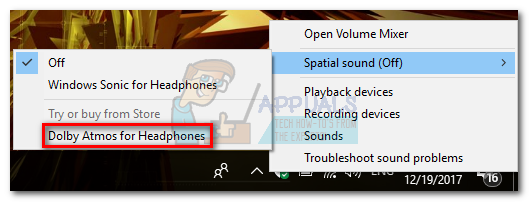
Both methods will take you to the same Dolby Acess store listing. Once there, press the Get button to download Dolby Acess on your system. When the download is complete, follow the guide below to set up an Atmos-enabled home theater (if you already have the right equipment). If you want to try a piece of Atmos for free, follow the second guide to set up Dolby Atmos for headphones.

How to Set up a Dolby Atmos Home Theater on Windows 10
Unlike Dolby Atmos for headphones, you won’t need to purchase a subscription or opt for a trial in order to configure your Atmos-enabled home theater – it’s “enough” to buy the hardware. If you have the right hardware (Atmos receiver + PC with HDMI output), follow the guide below to enable Dolby Atmos for a home theater on Windows 10:
- Open the Dolby Access app and click the With my home theater box.
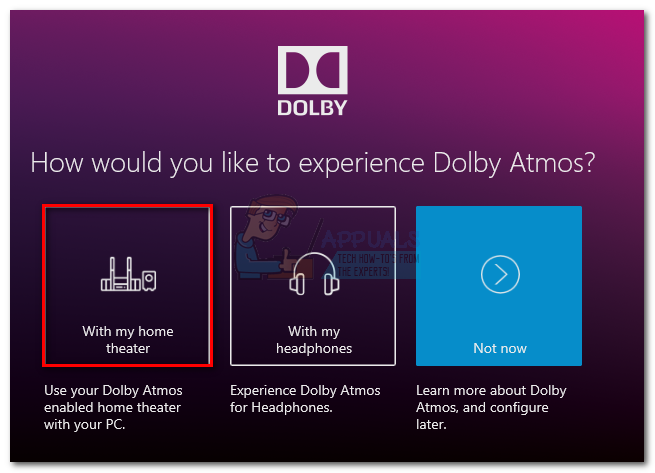
- Next, hit the Continue button at the first prompt and proceed to connect the HDMI cable from your home theater to your PC.
- Then, we need to make sure that the Atmos-enabled system is set as the default device. Do this by right-clicking on the sound icon (bottom-right corner) and select Playback Devices.
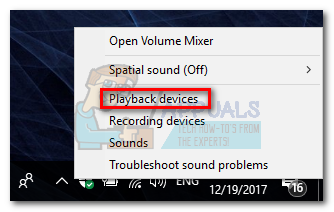
- Check whether the Atmos HDMI playback device is set as the default. If it’s not, select it and click the Set as Default button.
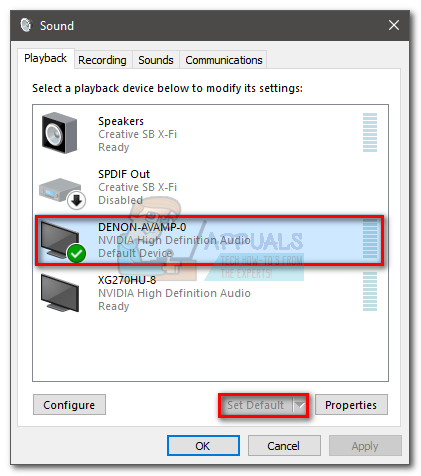
- Once you’ve set the Atmos-powered theater as the default, return to the Dolby Access app and click on Configure PC settings.

- Next, use the drop-down menu under Spatial sound format to select Dolby Atmos for home theater and hit Apply to confirm.
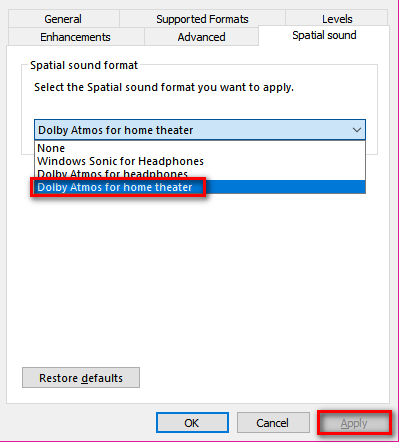 Note: If you don’t see a Dolby Atmos for home theater option, make sure your sound system has support for Dolby Atmos. If it has, double-check the HDMI connection. If necessary, unplug and repeat steps 3 and 4.
Note: If you don’t see a Dolby Atmos for home theater option, make sure your sound system has support for Dolby Atmos. If it has, double-check the HDMI connection. If necessary, unplug and repeat steps 3 and 4. - Finally, return to the Dolby Access App. Once the spatial sound in Windows 10 is set correctly, Dolby Access should automatically prompt you to calibrate your system.
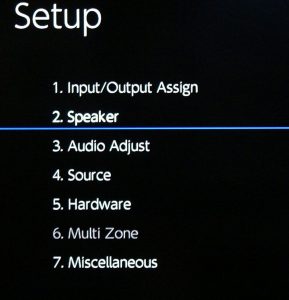 Note: Keep in mind that the calibration steps are highly dependent on your home theater configuration. After you follow the on-screen calibration steps, Dolby Atmos will be enabled on Windows 10.
Note: Keep in mind that the calibration steps are highly dependent on your home theater configuration. After you follow the on-screen calibration steps, Dolby Atmos will be enabled on Windows 10.
How to Set up a Dolby Atmos for Headphones on Windows 10
If you decide to try the inexpensive version of Dolby Atmos, you should now that the technology is not free. Well, actually it is, but just for 30 days. After the trial period, you’ll need to spend $15 to get the technology indefinitely. It’s unclear why Microsoft choose to integrate this technology with Windows 10, considering the fact that they released Sonic for Headphones at the same time – a technology almost identical to Dolby Atmos for headphones.
Whatever the reasons, it’s clear that Microsoft didn’t pay the full licensing fees for Dolby Headphones, so Windows users can’t use the technology for free. As a result, you can try Dolby Atmos for headphones for free only for a limited period of time (30-day trial). But the good news is the 30-day trial won’t require you to enter your credit card details.
If you decide to give it a try, follow the guide below to set up Dolby Atmos for headphones on Windows 10:
- Open the Dolby Access app and click the With my headphones box.
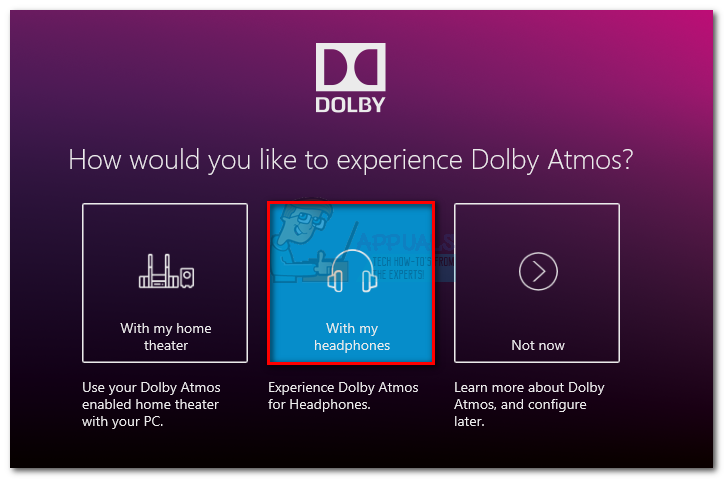
- Next, connect your headphones and select them from the menu to the right of the screen and click the Continue button. Upon hitting continue, the app will “check” for compatibilities issues between your headset and Dolby Atmos. But as some have pointed out, this has nothing to do with your headphones – this Atmos feature requires certain sound drivers that Windows 10 has by default. As long as you have Windows 10, every headset will be compatible, but the sound quality will obviously differ.
 Note: If the headset is not already the default playback choice, you’ll need to right-click on the sound icon located on your taskbar (bottom-right corner) and select Playback Devices. Once there, make sure that it’s the default choice. If it’s not, select it and hit the Set as Default button.
Note: If the headset is not already the default playback choice, you’ll need to right-click on the sound icon located on your taskbar (bottom-right corner) and select Playback Devices. Once there, make sure that it’s the default choice. If it’s not, select it and hit the Set as Default button.
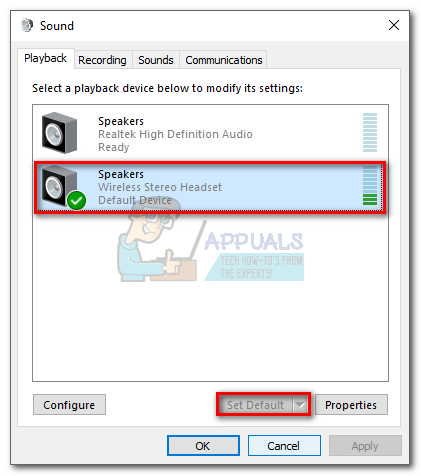
- In the Dolby Access app, click the 30-trial button. You can also opt to buy it indefinitely.
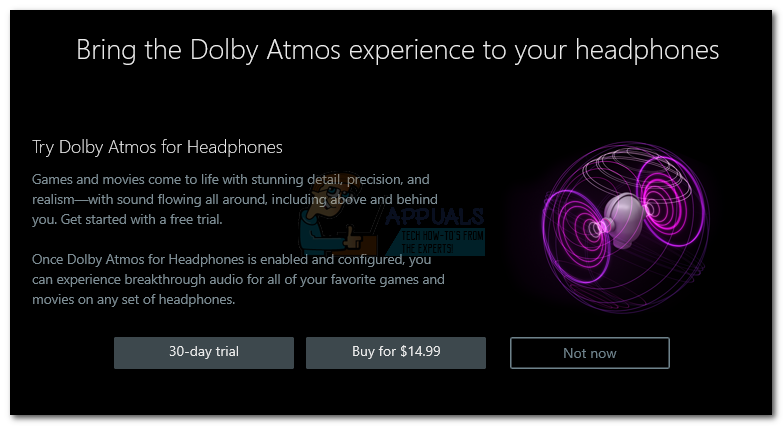 Note: If the 30-day trial button is not available, you have already used the Dolby Access trial with this particular Microsoft account.
Note: If the 30-day trial button is not available, you have already used the Dolby Access trial with this particular Microsoft account. - If you opt for the 30-day trial, you’ll be presented with a Microsoft Store Window. Hit Get to agree with Microsoft’s ToS.
 Note: This won’t automatically draw money from your credit card at the end of the trial period.
Note: This won’t automatically draw money from your credit card at the end of the trial period. - Upon returning to the Dolby Access window, you will be prompted to download additional content for the app. Hit Okay and wait for the download to complete.
 Note: If you are not prompted to install new content in the Dolby Access app, reboot your computer and open Dolby Access again.
Note: If you are not prompted to install new content in the Dolby Access app, reboot your computer and open Dolby Access again. - When the download is complete, you should see a new Configure PC settings button appearing. Click on it to open Speaker Properties.
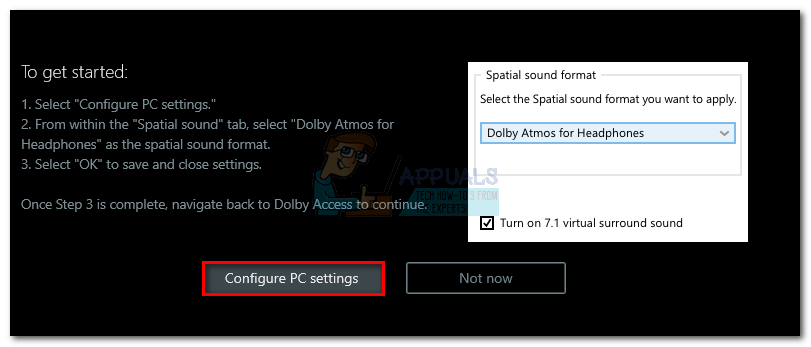
- In Speaker Properties under the Spatial sound tab, use the drop-down menu below Spatial sound format to select Dolby Atmos for Headphones. Hit Apply to save the changes.
 Note: You can also check the box next to Turn on 7.1 virtual surround sound. But keep in mind that it has the potential to create additional static noise, depending on the media you’re listening to.
Note: You can also check the box next to Turn on 7.1 virtual surround sound. But keep in mind that it has the potential to create additional static noise, depending on the media you’re listening to.
That’s it, Dolby Atmos is now configured for your headphones. You can return to the Dolby Access app to experience a list of curated videos, encoded with the Atmos technology.
Note: Keep in mind that not all media content will see an improvement while this option is activated. In order to witness the improvements with the new positional awareness feature, try playing a game or watch a video that is configured to work with Dolby Atmos.
If you decide to disable Dolby Atmos for headphones while the trial is still active, simply right-click on your sound icon (bottom-right corner) and set the Spatial Sound to Off.

Microsoft’s Free Alternative
Along with support for Dolby Atmos, Microsoft also implemented a built-in alternative to Dolby Atmos for headphones in the Creator’s Update. Technology-wise, Windows Sonic for Headphones does roughly the same thing as Atmos, but some argue it’s somewhat inferior to the Dolby alternative. But since audio quality can be very subjective, we won’t jump the fence and designate a clear winner in the DSP department.
To enable Windows Sonic for Headphones, move over to the bottom-right section of the taskbar and right-click on the sound icon. From there go to Spatial Sound and click on Windows Sonic for Headphones.
